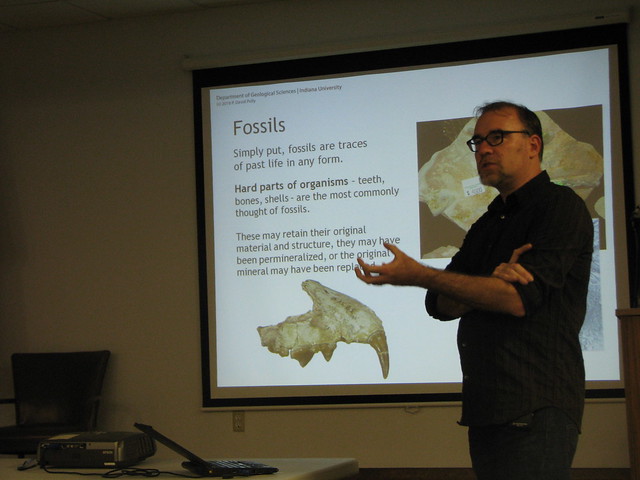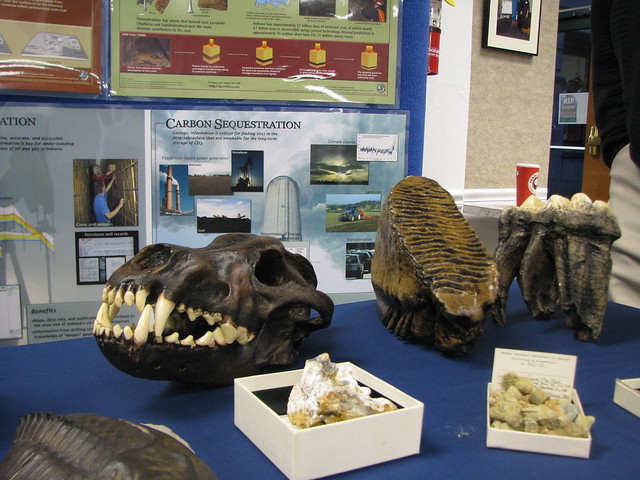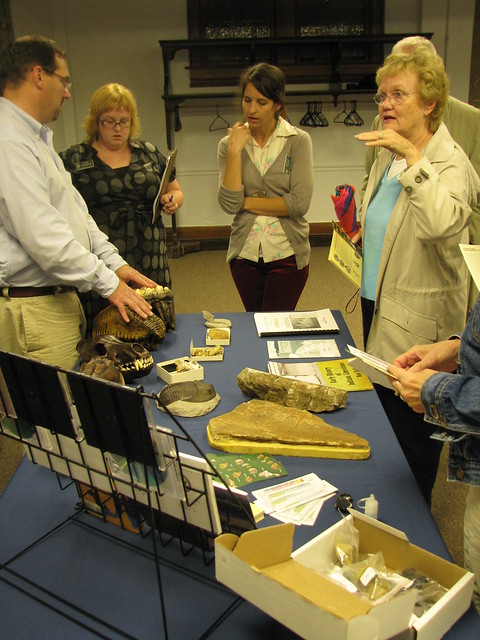
Dr. Polly begins his talk with a primer on paleontology.
After providing a solid foundation on what paleontology is all about, Dr. Polly zoomed in on Indiana geology, particularly the area around Bloomington. He began by talking about the Edwardsville Formation of Brown County and eastern Monroe County, which tells the story of the Borden River delta. During the Late Mississippian, as the Earth's geological processes were beginning to conspire to form the iconic supercontinent Pangaea, Indiana was situated much closer to the equator. The river delta of the Borden River was formed by sediment from the young mountain range to the southeast, eventually to become the Appalachians. This sediment, mud and sand, would form rock that could be readily eroded to create the signature ridges and valleys of Brown County. The inspiring scenery that brought artists flocking to the Nashville area in the last century has its roots in the days when the Smokies and their kin were rugged upstarts.
A formation like the Edwardsville is a basic unit of geological categorization, and this particular one is part of the appropriately named Borden Group. It's particularly famous for its crinoids, with major sites located on the shores of Lake Monroe and a particularly productive quarry near Crawfordsville which has yielded sixty-three species in forty-two genera. This was a robust, thriving ecosystem, a true crinoid heaven.
Dr. Polly then covered the Salem limestone that is pretty familiar to me, as it produced the chalky hunks that I occasionally dig up in my yard. It underlies most of Bloomington, and is evidence of a time when changing sea levels submerged the area, resulting in the famous limestone that built the economic backbone of the Stone Belt. To the west of Bloomington, the Mississippian shifts into the Pennsylvanian, the time of the great coal forests. The sandstones and shales and coal deposits tell the tale of swampy forests of Lycopsids, and this is when the "climate" part of the talk really kicked in.
The coal forests sucked in the CO2 of Earth's atmosphere in an unprecedented amount. When those plants died and piled up into great masses of peat, that CO2 was trapped - or sequestered - with the lasting effect of an atmosphere with a higher proportion of oxygen than before. This era, revealed to us by southern Indiana's bedrock, was a true natural revolution, one of the major turning points of Earth's history.
It was here that Dr. Polly's talk hit home. He managed to take the contentious issue of climate change and illustrate it through the story of earth's deep history (As Scott Sampson likes to say, the "Epic of Evolution"). It's quite simple, really: In the deep past, massive amounts of CO2 were gobbled up by plants and microorganisms and trapped underground. Humans discovered these deposits and during the industrial revolution began rereleasing it into the atmosphere, and we're beginning to feel the effects of that.

A dire wolf skull cast and fossil from the Harrodsburg Crevice, mammoth and mastodon molars, and more. Part of the Indiana Geological Survey collection.
The presentation was a joint effort of the IU School of Geological Sciences and the Indiana Geological Survey, which contributed a nice display booth, ably manned by Educational Outreach Coordinator Walter Gray. The table attracted plenty of attention from the audience, asking questions about the casts and fossils on display. I scored some nice informational cards discussing calcite, geodes, and typical Indiana fossils that now hang in my cubicle at work.

All in all, a fine way to celebrate my first Fossil Day. Though I would have loved to have seen a higher attendance, the audience that did come out was duly impressed by the materials provided by the IGS and Dr. Polly's presentation. I'm sure that it has the potential to connect with a lot of people. One of the big reasons that I began Under Indiana is to help spread the word. Next time, I'll be talking about the efforts of the Monroe County Historical Society to include more science in their work.

No comments:
Post a Comment